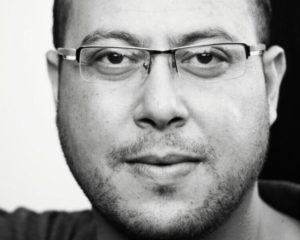
Fouad Agbaria
Fouad Agbaria
Fouad Agbaria was born in 1981 in the village of Musmus near Umm El Fahm in the Haifa district of historic Palestine. He is part of an important and empowered group of young Palestinian artists who are continually redefining what it means to be Palestinian citizens of Israel. Agbaria earned a bachelor’s degree from Bezalel Academy, Jerusalem, in 2004 and a master’s degree from Haifa University in 2014. He experiments with different styles, techniques and media including charcoal, oil, acrylic and lithography, dealing with many themes associated with the Palestinian narrative, identity and memory. He has participated in over twenty group exhibitions and has held three solo shows. His Post-Impressionist-style paintings depict simple rural pastimes, many of which have been lost but remain foremost in Agbaria’s memory. His use of the classic Palestinian symbol of the cactus – or sabra – pays homage to Palestinian survival and rebirth.
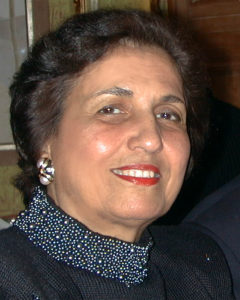
Tamam El-Akhal
Tamam El-Akhal
Tamam Al-Akhal was born in Yaffa, Palestine in 1935 and was forced to flee her home in 1948. Educated first in Jaffa, then in Beirut, Lebanon, and finally in Cairo, Egypt, Al-Akhal received her arts diploma in 1957. She taught art at the Makassed Girls College in Beirut from 1957 to 1960. Al-Akhal is one of the first Palestinian women to be formally trained in the arts. A long-time member of the General Union of Palestinian Artists and of the General Union of Arab Artists, she worked for many years in the Art and Heritage section of the Palestine Liberation Organization’s Department of Information and Culture. The expressive content of her work is based on the tragedy of Palestinian national life. She currently lives in Amman, Jordan and continues to paint to this day.
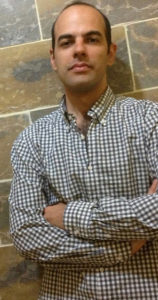
Hani Amra
Hani Amra
Hani Amra lives in his birthplace, Jerusalem. He studied arts and literature in France. Hani has been widely exhibited, including in Jerusalem, Hong Kong, Denmark, Italy and the United Kingdom. His work explores the medium of painting and photography, with a focus on what he describes as “re-constructing a world through an acute observation of his environment and its constant evolution in time.”
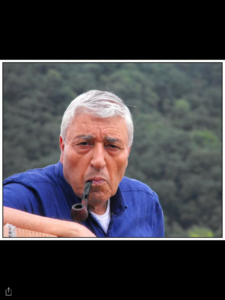
Nabil Anani
Nabil Anani
Nabil Anani was born in 1943 in Latroun, Palestine. A painter, ceramicist and sculptor, he is considered by many a key founder of the contemporary Palestinian art movement. After graduating in fine art from Alexandria University, Egypt in 1969, Anani returned to Palestine and began a fruitful career as an artist and teacher trainer at the United Nations training college in Ramallah. Anani held his first exhibition in Jerusalem in 1972 and has since exhibited widely in Europe, North America, the Middle East, North Africa and Japan. He pioneered the use of local media such as leather, henna, natural dyes, papier-mâché, wood, beads and copper. Anani was awarded the first Palestinian National Prize for Visual Art in 1997 and became the head of the League of Palestinian Artists in 1998. Anani dedicates much of his time to volunteer work in support of the League’s activities and has played a major role in the establishment of the first International Academy of Fine Art in Palestine.
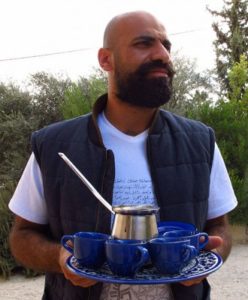
Ayed Arafeh
Ayed Arafah
Ayed Arafah grew up in Dheisheh refugee camp near Bethlehem. He has a bachelor’s degree in contemporary visual art from the International Academy of Art and a bachelor’s degree in social work from Al Quds Open University. Combining classic and contemporary media, he explores conceptual images to better understand the self in relation to politics, culture and economics. His currently lives in Ramallah.
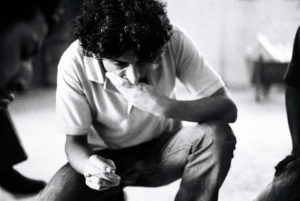
Ayed Arafeh
Rafat Asad
Rafat Asad was born in Nablus in 1974 and was awarded a bachelor’s degree in fine arts from Al Najah University in 1998. Though a painter first and foremost, Asad is a multi-disciplinary artist, producing light and sound installations as well as video and performance pieces. Taking abstract painting as a point of departure, his work has evolved to focus on the Palestinian landscape. As a result, Asad’s more recent work has become unique and somewhat minimalist in style. Asad has participated in group exhibitions including the 11th Havana biennale, Cuba (2012), Colors of Life, Zawyeh Gallery in Ramallah (2014); the First Alexandria Symposium for Mediterranean Arts, Alexandria, Egypt (2015) and many other important group exhibitions in Palestine, Europe, Japan, the United States and the Arab world. He has also participated in many art workshops and residencies, such as the residency program in cooperation with Delfina Studios Trust, London (2006), Slade School of Art, London (2012), and Cité des arts, Paris (2015). Additionally, he took part in the Shatna workshop in Jordan (2007) and the summer arts workshop in Styria, Austria (2009). He is a founding member of an artist-run gallery space called Al Mahatta (“The Station”) in Ramallah, where he currently lives.
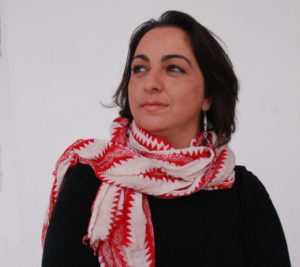
Rana Bishara
Rana Bishara
Rana Bishara, born in 1971, was raised in Tarsheha, Upper Galilee. She received a bachelor’s in Fine Arts, Women Studies and Philosophy from Haifa University in 1993. In 2003, with a Fulbright scholarship, she completed her master’s in Fine Arts at the Savannah College of Art and Design. She taught art in Jerusalem at Al Hoash Gallery, the YWCA and headed the art department at Al Quds University. She currently lives in Beit Jala where she teaches at Dar Al-Kalima College of Arts and Culture in Bethlehem and works as a freelance artist. Bishara mainly creates installations, conceptual art and performance utilizing symbols connected to the memory, identity and heritage of Palestine. She expresses personal and political messages about human rights, using mixed media to connote durability, fragility and ubiquity. Bishara’s has exhibited in solo and group shows locally in the Arab world, Europe, Scandinavia, and North America. Her work can be found in private collections as well as galleries and museums. She has curated exhibitions for various United Nations agencies and designed a monument for the thirtieth anniversary of the Sabra and Shatila’s massacre that stands in France.
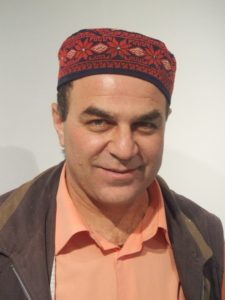
Ahmed Canaan
Ahmed Canaan
Ahmad Canaan, born in the town of Tamra in 1965, studied art at the prestigious Bezalel Art Academy in Jerusalem, graduating in 1989. In 2009, he received a diploma in Museum Studies from Tel Aviv University. With a career that spans over thirty years, Canaan has participated in countless international exhibitions and painting and sculpture symposiums in Israel, the Palestinian Authority, Oman, Germany, Japan, Jordan, Korea, the United States, Russia, France, Wales, Poland, England, Egypt, Qatar, Hungary, Greece, Turkey, Morocco, and the United Arab Emirates. With a steadfast commitment to the arts, not only is Canaan an artist, a curator, and an instructor, but he is also the founder of the municipal gallery in Tamra. His paintings contain many motifs drawn from the landscape of Palestine and from Palestinian heritage and culture, including historical figures like Salah ad-Din and traditional Palestinian costumes and dance.
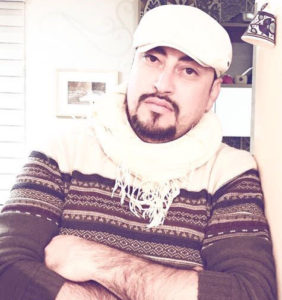
Ziad Yousef Hajali
Ziad Yousef Hajali
Ziad Yousef Hajali was born in Jerusalem in 1983 and now lives in Ramallah. In 2009, he earned a bachelor’s degree in fine art from Al-Zaytoonah University in Jordan with a specialization in graphic design. With a special interest in silkscreen, woodcutting, abstract painting and collage, Hajali makes, teaches, produces and curates art that express his belief in “art for all.” In addition to volunteer work with El-Funoun Dance Troupe and Palestine International Festival, he has been a member of the public association of Ramallah’s Al-Mahatta Gallery’s and served in their administrative association from 2011-2013.
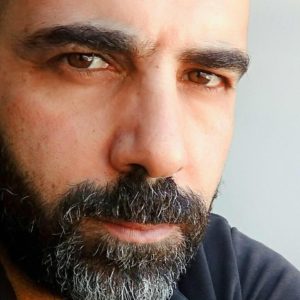
Michael Halak
Michael Halak
Michael Halak was born in 1975 in Fassuta village in the upper Galilee, Palestine. He currently lives and works in Haifa. After studying fine arts at Haifa University, Halak won a residence scholarship in 2005 to attend the Academy of Art in Florence, Italy, where he perfected his hyper-realist style. He graduated with an M.F.A. from Haifa University in 2009. Halak’s works move along the frontier between hyper-realism and conceptualism. The illusion of reality represented on canvas may be seductively beautiful and perfect, but equally conveys feelings of disruption and disintegration, impermanence, hybridity, entrapment or categorization. Halak has exhibited extensively in museums, including the Tel Aviv Museum of Art, Herzliya Museum of Contemporary Art, and the Haifa Museum of Art. He has also exhibited in galleries in the Middle East, Europe and the United States. Halak has won several awards, including the Ministry of Culture and Sports Visual Art Award (twice) and the Rappaport Prize.
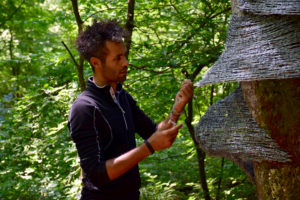
Abdul Rahman Katanani
Abdul Rahman Katanani
Abdul Rahman Katanani was born in 1983 in Sabra refugee camp, Beirut, Lebanon, where he continues to live. A third generation Palestinian refugee, Katanani first worked on political cartoons inspired by the work of Palestinian cartoonist Naji al-Ali. Katanani attended the Lebanese University in Beirut, where he obtained a diploma and a master’s degree in fine art. In 2008, he received a Special Mention at the Salon d’Automne held by Sursock Museum in Beirut, and in 2009 he received their Young Artist Prize. Katanani was a resident artist at the Cité internationale des arts in Paris and at the Centre d’art de Nanterre. Katanani makes his art out of materials found in the camps, such as scrap metal, barbed wire, cardboard, old clothes, and old utensils. His artwork has sold in auctions by Christie’s and has been exhibited in Qatar, Lebanon, Germany, and elsewhere. In 2016, Artnet News called Katanani one of “the strongest mid-career artists in the Arab world.” His artistic works depict the experience of his people, the Palestinian refugees. Accordingly, his art reflects the often contradictory feelings of suffering and endurance, hopelessness and hopefulness, pain and happiness, along with nostalgia for a beloved homeland.
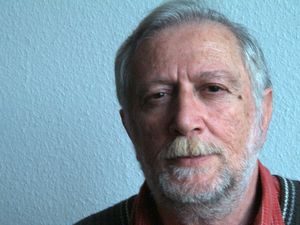
Suleiman Mansour
Suleiman Mansour
Suleiman Mansour, known most famously for his 1973 work Camels of Hardship depicting an old porter carrying Jerusalem on his back, was born in 1947 in Birzeit. During the first Intifada against Israeli occupation (1987-1993), Mansour and other artists in the “New Vision” art movement started boycotting Israeli art supplies, instead using local materials like mud and henna. For Mansour, art aids the continuation and revival of Palestinian identity, particularly as it captures images of the land and people working on the land. By keeping roots in the ancestral homeland, Mansour enables Palestinians to continue to lay claim to it. Mansour – also a cartoonist, art instructor and author –has contributed greatly to art education and promotion in the West Bank. He is now regarded as a cultural leader in Palestine. Co-founder of the Wasiti Art Center in Jerusalem, Mansour has exhibited in Palestine/Israel, the United States, Japan and Korea and across the Arab world and Europe. (Written by Sarah Rogers, PhD, for “Sky Over the East,” 2014.)
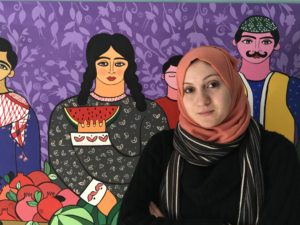
Dina Mattar
Dina Mattar
Dina Mattar was born in 1985 and lives and works in Gaza. She graduated in 2007 from Al-Aqsa University with a bachelor’s degree in art education. In 2012, she was selected to participate in the Cité internationale des arts in Paris. In 2014, she presented her work at the Katara Art Center in Qatar. She participated in the exhibition “Transformations,” which traveled among French cultural centers in Palestinian cities. Mattar’s work has been exhibited with the Arts Council of Northern Ireland, and in Britain, Jordan, France, Switzerland, the United States, Argentina, Dubai and Abu Dhabi. She is a founding member of the Eltiqa Group for Contemporary Art in Gaza.
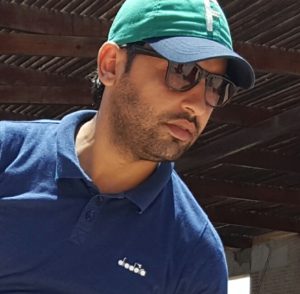
Marwan Nassar
Marwan Nassar
Marwan Nassar is a Palestinian artist born in Gaza in 1984. He graduated from the Fine Arts Faculty at Al Aqsa University and works as a lecturer at the Faculty of Art in the University College in Gaza. He has curated many exhibitions in the Gaza Strip and the West Bank. He has also participated in many Arabic regional exhibitions and in the international Imago Mundi project. Nassar supervises artistic workshops aimed at developing the cultural and artistic abilities of the postgraduate students of visual arts in Gaza. He organized a solo exhibition sponsored by Qattan Foundation in collaboration with the French Consulate in Jerusalem in 2016-2017.
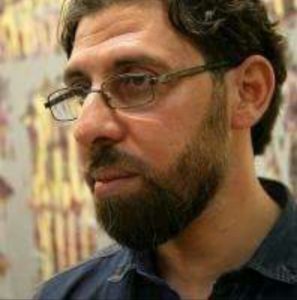
Motaz Omari
Motaz Omari
Motaz Omari, originally from Haifa, was born in Damascus in 1974 where he continues to live. He earned diplomas in fine arts, calligraphy, and architectural drawing. Omari trains children in fine arts and is a member of the Palestinian Fine Arts Association in Syria. His paintings have been exhibited in group shows in Syria, Palestine, Egypt, Lebanon, including the “Candles of Peace” exhibition at the Damascus Opera House. Omari had a solo show called, “Human Manifestations” in 2017 at the Damascus Cultural Center, and is a permanent participant in the exhibit, “Land Day March 30” in Syria. His pieces are in collections in several countries.
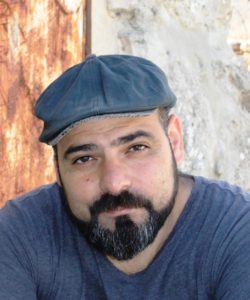
Bashir Qonqar
Bashir Qonqar
Bashir Qonqar was born in Beit Jala, Palestine in 1980. A self-taught artist, he studied social sciences in Germany, where he lived for seven years. In 2007 he returned to Bethlehem and worked in public relations for Children’s Relief Bethlehem and also as an art teacher at Dar Al Kalima Art College. Bashir’s father was killed in the first Intifada. This childhood experience influenced his life and work in many ways. Bashir uses different media and techniques including painting, drawing, digital work and installations to explore human behavior. His work has been exhibited in Palestine, Germany, Austria, Andorra, Italy, France, South Africa, Sweden, the United Arab Emirates and the United States.
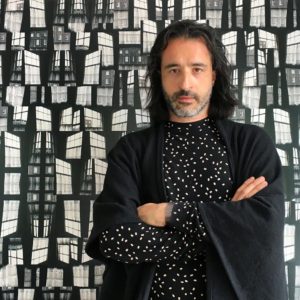
Steve Sabella
Steve Sabella
Steve Sabella, born in 1975 in Jerusalem, Palestine, is an award-winning artist, writer and public speaker based in Berlin. He uses photography and photographic installation as his principal modes of expression. His work has been exhibited internationally and is held in collections that include those of the British Museum in London and Mathaf: Arab Museum of Modern Art in Doha, where he was a commissioned artist for the inaugural exhibition in 2010. Sabella holds a master’s degree in photographic studies from the University of Westminster and a master’s degree in art business from Sotheby’s Institute of Art, London. In 2008, he received the Ellen Auerbach Award from the Akademie der Künste Berlin, leading to the publication of his monograph Steve Sabella—Photography 1997-2014. His memoir, The Parachute Paradox, published by Kerber Verlag in 2016, received international recognition and several awards. (Photo credit: Clementine Butler-Gallie)

Ismail Shammout 1930-2006
Ismail Shammout
Ismail Shammout was born in 1930 in the city of Lydda, Palestine. He was only 18 years old when on July 13, 1948, he and his family were evicted from their home in Palestine along with the majority of the population of the city of Lydda, after which he ended up in the refugee camp of Khan Younis, in the Gaza Strip. Since then, this painful journey of leaving his homeland has remained the central theme of his artistic expressions. Through his drawings he attempts to depict the painful experiences, the horrific journey of exile, and the uprooting of his family and his people. In 1950 Ismail enrolled in the College of Fine Arts in Cairo. In 1953, Shammout held his first exhibition, the first ever to be held by a Palestinian artist in Palestine. He displayed over sixty works of oil, watercolors and drawings, which included his now famous painting Where to? At the Fine Arts College in Cairo, Ismail met the Palestinian artist Tamam Al-Akhal, and they were married in 1959. In 1954, Shammout, with the participation of Tamam, opened his major exhibition in Cairo. The exhibition was sponsored and inaugurated by the late Egyptian President Jamal Abdul-Nasser. Upon his graduation from Cairo in 1954, Ismail joined the Academy of Fine Arts in Rome. Shammout was elected the first secretary general of the Union of Palestinian Artists in 1969, and the first secretary general of the Union of Arab Artists in 1971. For many years after that, he was a member of the General Union of Palestinian Artists and of the General Union of Arab Artists. He also headed the Art and Heritage section of the Palestine Liberation Organization’s Department of Information and Culture. In 1997, Ismail and Tamam were allowed to return to their beloved Palestine. Ismail Shammout passed away in July 2006, survived by his loving wife, their sons Yazid, Bashar and Bilal, and nine grandchildren.